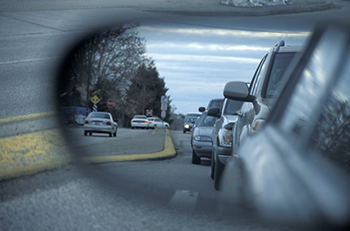 Driving is a very demanding activity which requires a lot of multitasking, because you have to focus on your own driving while still paying attention to other cars, motorcycles, bicycles, pedestrians, and even animals. Events take place simultaneously.
Driving is a very demanding activity which requires a lot of multitasking, because you have to focus on your own driving while still paying attention to other cars, motorcycles, bicycles, pedestrians, and even animals. Events take place simultaneously.
Even when you are driving only 30 mph, you are actually traveling 15 meters in a single second! Think about that. You can’t even do anything useful in a single second. It takes at least 3 seconds to find your favorite radio station.
This implies that you actually travel 50 meters while having no clue what is happening on the road (at 60 mph that would be a shocking 100 meters) every time you take your eyes off the road to find your favorite radio station. The best of all is that most of us do it every day without even thinking about it. This can have serious consequences. For example, you can hit a 700 pound deer and end up in a wheelchair for the rest of your life.
The bottom line is that you can never be too cautious while driving. Experts within the industry are aware that traveling by car is not really the safest way to travel (as opposed to air travel). They also acknowledge the risks and understand serious consequences of irresponsible driving. An expert team of personal injury lawyers who have recognized this problem has made a list of recommendations and guidelines which can greatly improve your safety while driving.
Contact a Melbourne Fl personal injury attorney if you have been involved in a serious automobile accident. Consider these safety tips while driving:
[one_half_column]
- Do not drive if you are tired
- Never drive over the speed limit
- Go well under the speed limit in case of deteriorating conditions on the road (heavy rain, gusts of wind, ice, storms)
- Trust your intuition and experience and do not take turn signals for granted (drivers often use them accidentally or change their mind half way through the crossroads)
- Keep a safe distance from cars in front of you (use a two-second rule to determine minimum distance)
- Do not turn or change lanes without using your own turn signals
- Think one step ahead and frequently use all of your mirrors (check for blind spots)
- Educate yourself about the concept of defensive driving and take additional classes if needed
- Always put your seatbelt on
- Check your tires each time before you sit behind a wheel
- Do not brake too hard if you don’t need too
[/one_half_column]
[one_half_column]
- Stop texting while driving
- Refresh your memory of traffic signs every year or two
- Keep your headlights on, even when the law says you don’t need to (especially while driving through forested areas)
- Don’t drive for more than 8 hours in one day and take short breaks every two hours
- Refrain from unpredictable and sudden steering wheel movements
- Don’t change lanes too often
- Keep enough lateral distance from vehicles around you
- Take your sunglasses off before entering a tunnel
- If you have to make a sudden turn, use all four turn signals instead of one
- Avoid following large trucks or buses too closely, because splashes from large tires can temporarily shut down your ability to see
- Make sure to have good wiper blades, clean windows and plenty of wind shield washer fluid
[/one_half_column]
